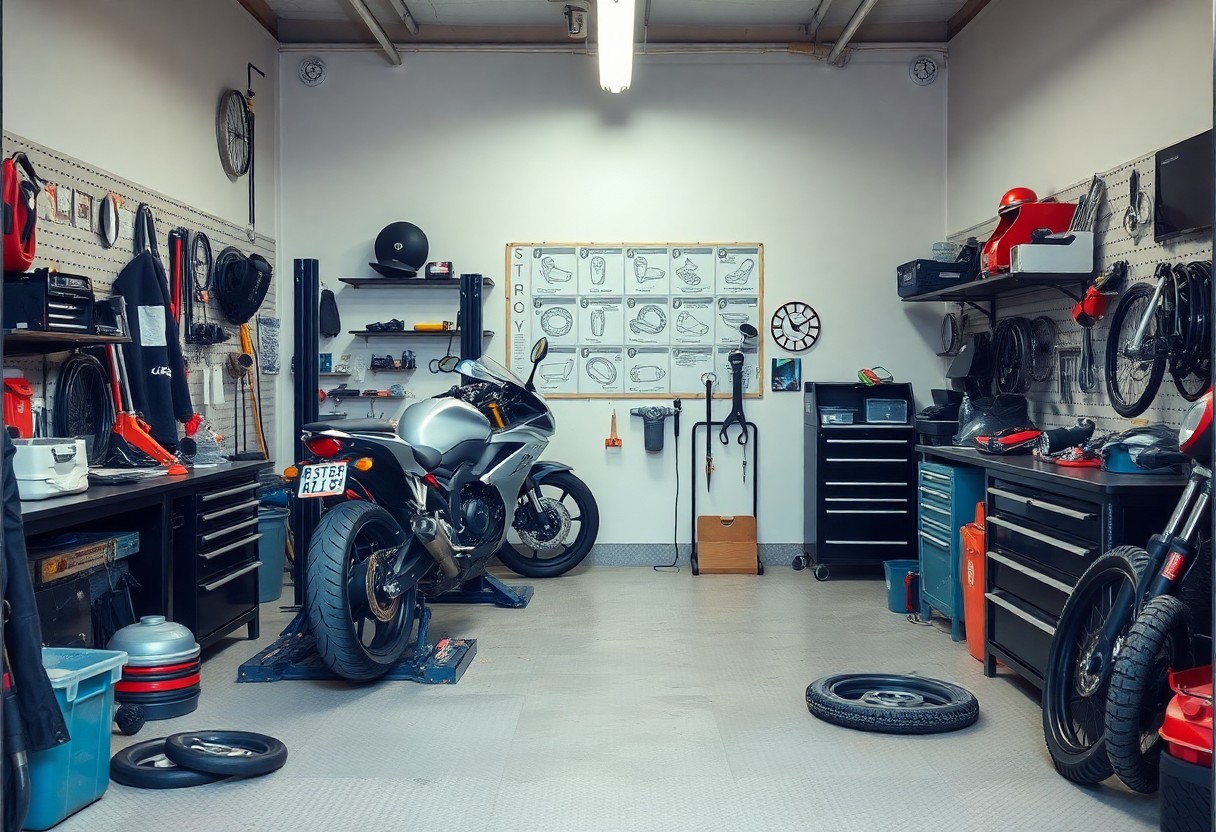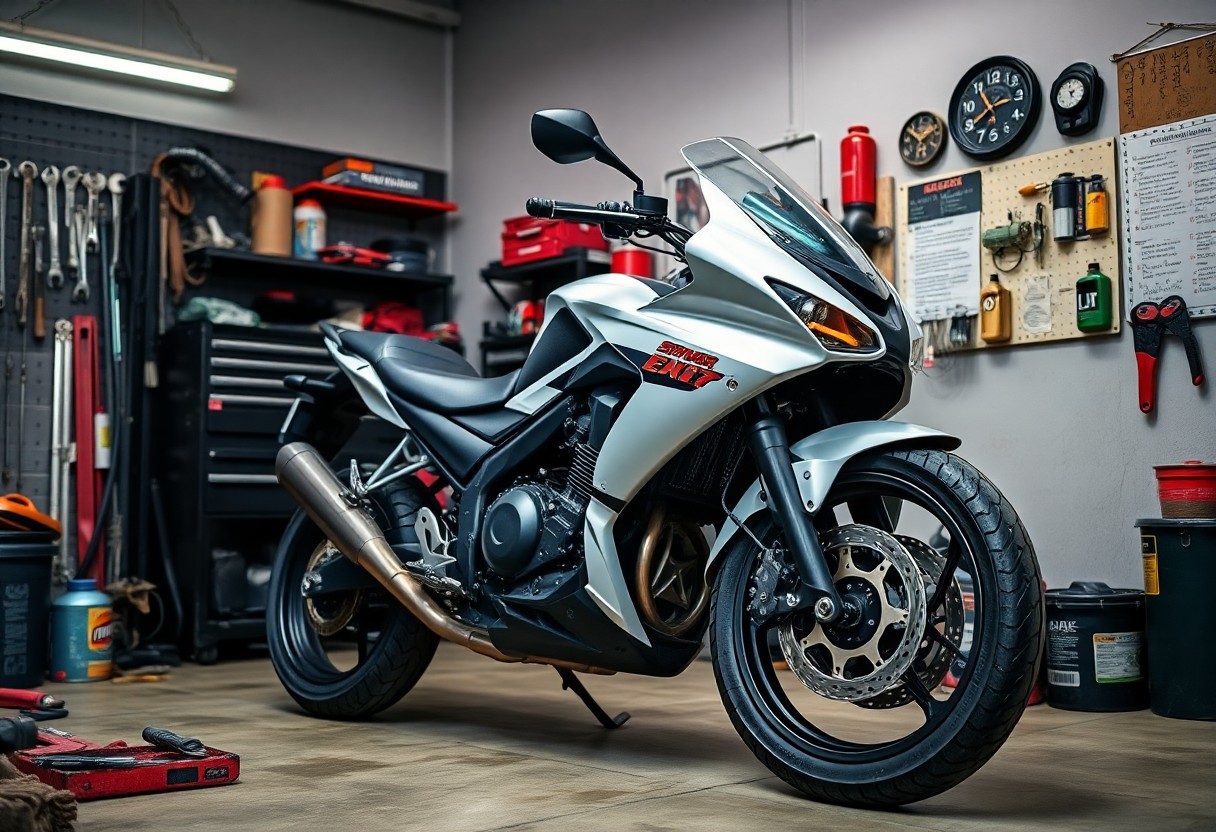You can easily keep your motorcycle in top-notch condition with just a few simple maintenance steps. Regular upkeep not only enhances the longevity of your bike but also ensures a smoother and more enjoyable ride. In this blog post, you will discover five straightforward maintenance tasks you can perform at home, empowering you to take charge of your motorcycle’s health and performance. From checking tire pressure to inspecting the chain, these tips will help you extend the life of your ride and enhance your overall motorcycling experience.
Understanding Your Motorcycle
As a motorcycle enthusiast, it’s necessary to grasp the fundamental aspects of your bike. Understanding your motorcycle helps you identify its unique features, performance capabilities, and maintenance needs. Familiarizing yourself with your bike empowers you to perform basic upkeep tasks more confidently, ensuring a safer and smoother riding experience.
Importance of Regular Maintenance
Understanding the significance of regular maintenance is key to ensuring the longevity and performance of your motorcycle. Regular checks can prevent unexpected breakdowns and costly repairs while enhancing safety on the road. By committing to a consistent maintenance routine, you keep your bike running efficiently and protect your investment.
Key Components to Check
Among the necessary components to check are the tires, brakes, oil, chain, and battery. Each of these elements plays a vital role in the overall performance and safety of your motorcycle. Keeping these components well-maintained not only ensures optimal functioning but also enhances your riding experience, allowing you to enjoy the open road with peace of mind.
Also, inspecting your tires regularly for wear and proper inflation can improve traction and handling. Checking your brakes ensures they respond reliably when you need them the most. Keeping an eye on your oil level and quality helps maintain engine performance, while a clean and lubricated chain contributes to a smoother ride. Finally, a fully charged battery is necessary for reliable starts and the functioning of electronic systems. By systematically checking these key components, you can address potential issues before they escalate, enhancing your motorcycle’s overall condition.
Step 1: Cleaning the Motorcycle
Any effective motorcycle maintenance routine begins with a thorough cleaning. Regularly cleaning your motorcycle not only enhances its appearance but also helps you identify potential issues like rust or leaks. By keeping your bike clean, you create a solid foundation for ongoing maintenance and protection against the elements. Take the time to give your motorcycle the attention it deserves, and you’ll ensure its longevity and optimal performance.
Tools and Supplies Needed
After gathering your cleaning supplies, you’ll be fully equipped to tackle the task. Essential tools include a soft microfiber cloth, a motorcycle-specific cleaning solution, a bucket, a stiff brush for hard-to-reach areas, and a hose or pressure washer for rinsing. Don’t forget to have chain cleaner and lubricant handy, as cleaning and maintaining your chain is a significant part of the motorcycle cleaning process.
Techniques for Effective Cleaning
Beside having the right tools, proper techniques are key to achieving a spotless motorcycle. Start by rinsing the bike to remove loose dirt, then apply the cleaning solution and gently scrub with the brush. Pay special attention to the wheels and chain, where grime tends to accumulate. A thorough rinse is imperative to remove all soap residues; consider using a little water pressure for stubborn spots while avoiding sensitive components.
Indeed, effective cleaning requires a bit of technique to safeguard your motorcycle’s surfaces. Start with a gentle rinse to loosen dirt and debris, focusing on any build-up around the wheels and undercarriage. When applying your cleaning solution, use a soft brush or cloth to prevent scratching. Be mindful of your motorcycle’s components; avoid high-pressure water on electrical parts and bearings. Finally, ensure you dry all surfaces to prevent water spots and potential rust. This attention to detail during cleaning can significantly extend the life and performance of your motorcycle.
Step 2: Checking and Changing the Oil
Now that you understand the importance of maintaining your motorcycle, it’s time to focus on checking and changing the oil. Regular oil checks and changes help ensure your engine runs smoothly and efficiently, ultimately extending the life of your bike. You can perform this simple task at home with just a few tools and some patience.
How to Check Oil Levels
Any time you check your oil levels, start by positioning your motorcycle on a stable surface. Allow the engine to cool, then remove the dipstick or oil filler cap. Wipe it clean, reinsert, and then pull it out again to observe the oil level. Ensure the oil sits between the minimum and maximum indicators to maintain optimal performance.
Steps to Change the Oil
Changing your oil is a straightforward process that enhances your motorcycle’s performance. Begin by warming up your engine for a few minutes to thin the oil, making it easier to drain. Turn off the engine, then place a drain pan beneath the oil pan, remove the drain plug, and allow the old oil to flow out completely. Replace the drain plug, refill with the recommended type of oil, and check the levels with the dipstick.
Considering the importance of using the correct type of oil for your motorcycle, always refer to your owner’s manual for specifications. This ensures you provide the right viscosity and grade for optimal engine performance. Additionally, it’s wise to replace the oil filter every time you change the oil for a cleaner result. After filling, let the engine run for a short period and check for leaks around the drain plug and filter, ensuring everything is secure.
Step 3: Inspecting and Maintaining Tires
Not paying attention to your motorcycle tires can lead to unsafe rides and costly repairs. Regularly inspecting and maintaining your tires is crucial to ensure optimal performance and longevity. Make it a habit to check your tires for any visible damage, cracks, or foreign objects. A well-maintained tire not only enhances your safety but also improves your bike’s overall handling and fuel efficiency.
Tire Pressure and Tread Depth
Above all, maintaining the correct tire pressure and monitoring tread depth is vital for safe riding. Check your tire pressure regularly using a reliable gauge and adjust as needed based on the manufacturer’s recommendations. Additionally, inspect tread depth; insufficient tread can drastically affect traction, especially in wet conditions.
When to Replace Tires
Across each riding season, be aware of the signs indicating it might be time to replace your tires. Look for uneven wear, visible cracks, or tread depth below the recommended limit. Riding on worn-out tires can compromise your safety and handling, so keep an eye out for any significant changes in tire performance.
A good rule of thumb is to replace your motorcycle tires every 5-7 years, even if the tread appears acceptable, as rubber deteriorates over time. Additionally, if you find yourself frequently replacing tires due to punctures or damage, it may be time for a quality upgrade. Always consult your manufacturer’s guidelines for specific recommendations regarding tire replacement, ensuring you stay safe on the road.
Step 4: Adjusting the Chain and Brakes
Once again, it’s time to ensure your motorcycle runs smoothly by focusing on the chain and brakes. Both are integral to your bike’s performance and safety. By regularly checking and adjusting them, you’ll have better control and prolong the life of these components. Through simple maintenance tasks, you can enhance your riding experience while keeping potential issues at bay.
Chain Tension and Lubrication
An properly adjusted chain tension is crucial for optimal performance. Begin by checking the manufacturer’s specifications for the correct slack, then adjust accordingly. After tension adjustment, apply a suitable chain lubricant to ensure smooth operation and reduce friction. Regular lubrication not only increases chain lifespan but also enhances your motorcycle’s overall efficiency.
Brake Inspections and Adjustments
About your brakes, conducting regular inspections is vital for your safety on the road. Check the brake pads for wear and ensure the brake fluid is at the appropriate level. Adjusting the brake lever and ensuring there’s sufficient responsiveness can significantly enhance your braking performance.
Lubrication is another key element when maintaining your brakes. Apply lubricant to the pivot points of the brake lever and caliper components to prevent wear and provide smooth operation. Ensure that any excess lubricant does not come into contact with brake pads or rotors, as this can compromise braking efficiency. A well-lubricated braking system ensures that your motorcycle responds instantly when you need it most.
Step 5: Final Checks and Tips
Despite all your hard work in maintaining your motorcycle, don’t forget to perform final checks before hitting the road. This step ensures that everything is in order and ready for a safe ride. Here are some tips to consider:
- Inspect tire pressure and tread depth.
- Check brake fluid levels and functionality.
- Test turn signals and headlights.
- Ensure the chain is properly lubricated and adjusted.
Knowing these final checks can make a big difference in your riding experience.
Overall Safety Checklist
Any motorcycle ride begins with a solid safety checklist. Verify that your helmet fits correctly and that your riding gear is in good condition. Make sure all mirrors are adjusted properly and that your riding position is comfortable and safe. Incorporate these simple checks into your routine for peace of mind each time you ride.
Seasonal Maintenance Considerations
Overall, each season brings different challenges for your motorcycle’s performance. Be proactive about checking items like coolant levels before summer heat or battery condition in winter. Adjusting your maintenance routine to the seasons ensures that your bike remains safe and efficient throughout the year.
Considerations for seasonal maintenance also include changes in tire pressure with shifting temperatures and the importance of winterizing your motorcycle if it’s stored. In colder months, consider using a battery maintainer to keep it charged. During wet seasons, ensure that your brakes are functioning optimally, and check your tires for wear and grip. Tailoring your motorcycle care to the seasons can greatly enhance its longevity and your safety.
Conclusion
Following this guide on the 5 simple steps for effective motorcycle maintenance you can do at home will help you keep your bike in top condition and enhance your riding experience. By regularly checking your oil, tires, chain, brakes, and lights, you can identify potential issues early and address them before they become more significant problems. This proactive approach not only prolongs the life of your motorcycle but also ensures your safety on the road. Embrace these maintenance tasks as part of your routine, and enjoy the peace of mind that comes with a well-maintained ride.


